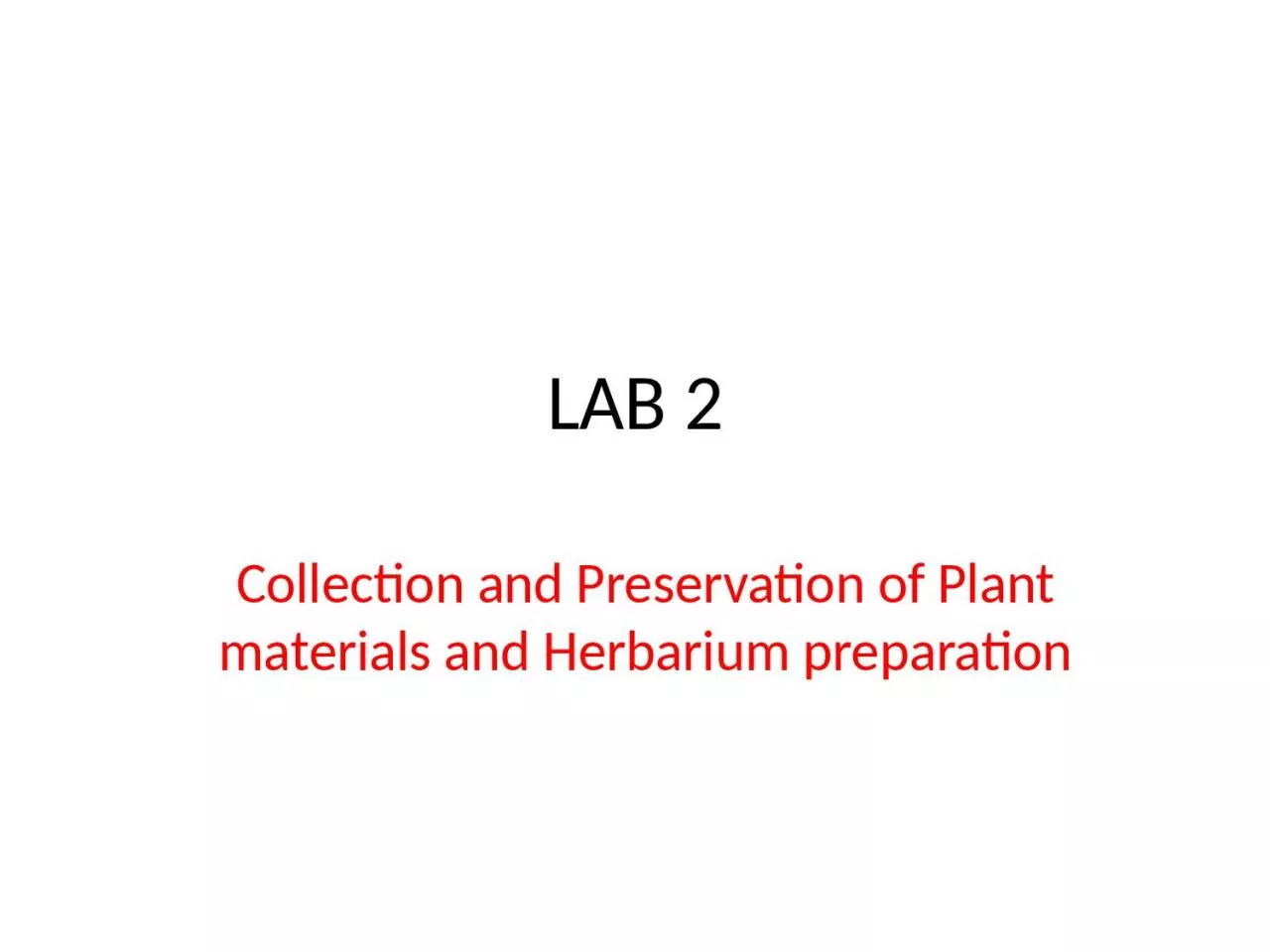

Plant Collecting and Documentation Collections Samples of plants Dried or liquid preserved Kept alive grown in greenhouse or garden Ѵ Preservation is of types 1 Dry PreservationHerbarium ID: 1019665
Download Presentation The PPT/PDF document "LAB 2 Collection and Preservation of Pla..." is the property of its rightful owner. Permission is granted to download and print the materials on this web site for personal, non-commercial use only, and to display it on your personal computer provided you do not modify the materials and that you retain all copyright notices contained in the materials. By downloading content from our website, you accept the terms of this agreement.
1. LAB 2Collection and Preservation of Plant materials and Herbarium preparation
2. Plant Collecting and DocumentationCollections: Samples of plants Dried or liquid preserved. Kept alive, grown in greenhouse or garden
3. ѴPreservation is of types:1. Dry Preservation/Herbarium: A collection of dried plant specimen mounted on sheet is known as Herbarium.2. Wet Preservation: Very fleshy and delicate structures, including small algae are best preserved in air tight Glass jars with liquid preservatives.
4. Wet preservation:
5. Ѵ Why collect?Provide resource material for plant systematics studies.Serve as a reference collection for named taxa, known as a voucher specimen. a) Type specimen in formal naming b) Reference for the identity of a taxon -in systematic studies -in field studies, e.g., floristic surveys3) Provide information about the plant in a native habitat: put info. in database
6. Ѵ Should you collect? What to collect?Generally DON’T collect “listed” taxa: rare, endangered, or threatenedMust know ahead of time which these are!When you collect, use “1 to 20” rule: – For every herb you collect, make sure there are at least 20 in the population. – For every branch of a shrub or tree, make sure there are at least 20 more.
7. How to collect? Herbs: Must dig up at least one entire plant to show root or rootstock (e.g., corm, bulb, rhizome)Shrubs, trees, vines: One branch sufficient.Collect a representative specimen that shows vegetative and reproductive parts (in flower, fruit, cone, with sporangia, etc.)
8.
9. Cardboards: ca. 12” x 18” Newspaper, ca. 11.5” x 16.5”Tighten strapsPlace in plant drier,2-3 daysRemove and check if dry (if it feels cool, not dry)Plant Press
10. Liquid-Preserved Collections Anatomy, embryology, palynology, etc.:FAA (Formalin - Acetic Acid - Alcohol (ethanol)Cytology (chromosome numbers):Carnoy’s (100% ethanol : glacial acetic acid)Living Collections :Grow in greenhouse or botanic gardenValuable for long-term studies
11. Ѵ How to make a Herbarium?1) Collecting the plants2) Pressing and Drying3) Mounting
12. 1) Collecting the plants Choose good representatives of the plants species Be careful that these plants must include root, stem, flower and fruitTake notes and record by taking photos in the field at the time of collection, Note these factors below: “Date, collection number, location, habitat, habit, special characteristics”
13. 1) Collecting the plants Choose good representatives of the plants species Be careful that these plants must include root, stem, flower and fruitTake notes and record by taking photos in the field at the time of collection, Note these factors below: “Date, collection number, location, habitat, habit, special characteristics”
14. Collect specimens in dry conditions, a good time being mid-morning, after the dew has dried but before the heat of the day causes plants to wilt. If specimens are at all wet or you need to wash soil off the roots then dry them carefully before pressing. Use a pencil for these notes rather than a pen because any damp/wetness can cause ink to smudge and be unreadable
15. Materials for plant collecting:Plant pressPlastic bags or nylon bagGarden secateurs & trowel Small note book & pencil Jeweller’s tags (optional) Camera (optional) GPS & altimeter (optional)
16. PRESSING AND DRYING
17. PRESSING & DRYING- Plants must be clean before pressingThey must also be put in a plastic bag or nylon bag, if it is hot they must be watered to be freshPlace your plant between folded-out sheets of newspaper, although flimsy or greaseproof paper is preferable for delicate material Arrange the plant carefully, trying to avoid overlapping. When you have finished arranging the specimens within the newspaper sheets (or whatever combination of papers you have chosen), you then need to intersperse them between corrugated card sheets to aid ventilation. Finally place everything in your press and tighten well.
18. For the first two to four days you will need to check daily and change the blotting paper and/or other surrounding papers, and retighten the press, but as the plants dry these checks can become less frequent.Warmth may be used to improve the drying rate, An oven set at 50°C may be used but the heat must be no higher, otherwise the specimen will become very brittle and damaged.
19. Pressing:
20. Pasting:
21. MOUNTING Cartridge paper for mountingyour specimens should preferablybe A3 size and acid-free; the weight should be a minimum 180g/m2, and ideally with a roughtextured surface Using only one side of your thick A3 cartridge paper, arrange your specimens carefully, making sure that they represent the way the plant grows naturally
22. Example Herbarium Label Scientific name: Ranunulaceae, Ranunculus ficaria (family, genus and species)Vernacular name(s): Lesser Celandine, PilewortCollector’s name and specimen number: Lawrence 1Date of collection: 20th March 2003Locality: Orleans House Gardens, Twickenham, EnglandHabitat: damp, clay soil, 20 yards from riverbank, growing in dappled shade on the edge of deciduous woodland; nearby plant is Dock (Rumex obtusifolius).Habit: perennial herb, up to 20 cm tall, with stems creeping and rootingCharacteristics: leaves hairless glossy green, flowers bright glossy yellow, turning white with age
23. Herbarium sheet:
24. Herbarium card
25. Exercise 2Prepare 2 herbarium sheet with their description.